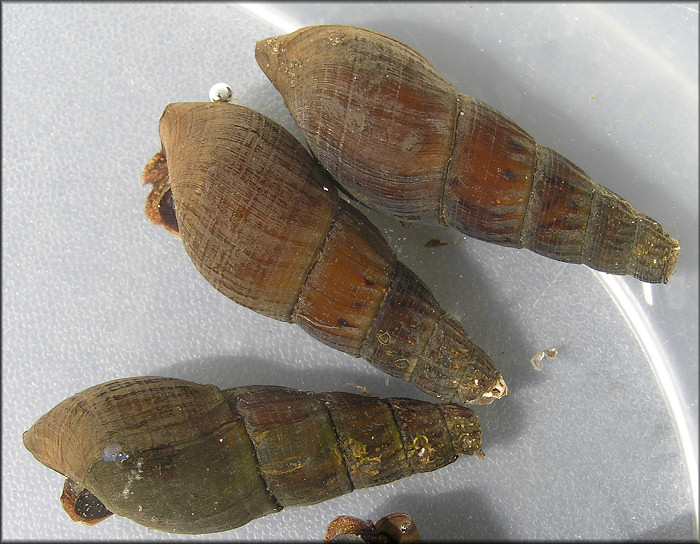Invasion History
First Non-native North American Tidal Record: 1996First Non-native West Coast Tidal Record:
First Non-native East/Gulf Coast Tidal Record: 1996
General Invasion History:
Melanoides turricula is a freshwater snail described from the Phillipines, possibly conspecific with the more widespread invasive Asian snail M. tuberculata (Lee 2006; Thompson 1999). It was reported from Florida waters by 1984 (Thompson 1984, cited by McCann et al. 1996). While this snail prefers clearer, more flowing water than M. tuberculata, it does occur in tidal fresh tributaries of Tampa Bay (Baker et al. 2004). Melanoides turricula is also known from nontidal freshwaters of Florida (Lee 2006; USGS Nonindigenous Aquatic Species Program 2013). One population, in an artificial pond near Jacksonville, was initially identified as M. turricula, but was later considered to be an unidentified species (Lee 2013). We have not found introduced records of this snail from elsewhere in North America, or in the rest of the world.
North American Invasion History:
Invasion History on the Gulf Coast:
Melanoides turricula was reported from springs and streams in Florida at least as early as 1984 (Thompson 1984, cited by McCann et al. 1996). The precise date of its introduction is unknown, owing to confusion with M. tuberculata. It was present in Eureka Springs, adjacent to the tidal Hillsborough River, east of Tampa Bay, by 1996 (McCann et al. 1996). It has aso been reported from the non-tidal Withlacoochee River in Marion County (McCann et al. 1996 USGS Nonindigenous Aquatic Species Program 2013).
Description
Melanoides turricula is a medium-sized freshwater snail. It has an elongate-conical, dextrally coiled, shell with 8-12 whorls and a strongly pointed spire, though the tip is usually eroded. The shell is sculptured with fine spiral threads and fine vertical ribs on the uppermost whorls. The base of the shell usually lacks a spiral band. The aperture has a tear-drop shape and the operculum is horn-colored. The shell reaches a length of about 30-40 mm. The shell is olive-green, with vertical reddish flames and spots. This form could be an ecotype or subspecies of the highly variable and widespread M. tuberculata (Thompson 2004), but we will treat it provisionally as a distinct species. There are at least 47 named species of Melanoides, excluding synonyms (Galli 2013), so the identification of these snails is challenging.
Taxonomy
Taxonomic Tree
| Kingdom: | Animalia | |
| Phylum: | Mollusca | |
| Class: | Gastropoda | |
| Order: | Neotaenioglossa | |
| Family: | Thiaridae | |
| Genus: | Melanoides | |
| Species: | turricula |
Synonyms
Melanoides turriculus (None, None)
Potentially Misidentified Species
None
Tarebia granifera
None
Ecology
General:
We have very little information about the biology of Melanoides turricula (Fawn Melania), but its life history and ecology is expected to be similar to that of M. tuberculata, with predominantly parthenogenetic reproduction and direct development (Livshits and Fishelson 1983). Snails of this family feed on detritus and microalgae (Miranda and Perissinotto 2012).
Food:
Algae, Aquatic plants
Trophic Status:
Herbivore
HerbHabitats
| General Habitat | Nontidal Freshwater | None |
| General Habitat | Fresh (nontidal) Marsh | None |
| General Habitat | Grass Bed | None |
| General Habitat | Coarse Woody Debris | None |
| General Habitat | Swamp | None |
| General Habitat | Unstructured Bottom | None |
| Salinity Range | Limnetic | 0-0.5 PSU |
| Tidal Range | Subtidal | None |
| Vertical Habitat | Epibenthic | None |
Tolerances and Life History Parameters
| Minimum Salinity (‰) | 0 | None |
| Maximum Length (mm) | 40 | Thompson (2004) |
| Broad Temperature Range | None | Subtropical-Tropical |
| Broad Salinity Range | None | Nontidal Limnetic-Limnetic |
General Impacts
No impacts have been reported for Melanoides turricula in Florida waters. Like M. tuberculata, it is a potential competitor with native freshwater snails (Warren 1997), but the extent of its abundance and distribution is unknown.Regional Distribution Map
Non-native
Native
Cryptogenic
Failed
Occurrence Map
References
Baker, Patrick; Baker, Shirley M.; Fajans, Jon (2004) Nonindigenous marine species in the greater Tampa Bay ecosystem., Tampa Bay Estuary Program, Tampa FL. Pp. <missing location>Lee, Harry 2001-2015 Harry Lee's Florida Mollusca Checklists. <missing URL>
Livshits, G.; Fishelson, L. (1983) Biology and reproduction of the freshwater snail Melanoides tuberculata in Israel, Israel Journal of Zoology 32: 21-35
Mattson, Robert A. (2011) <missing title>, St. Johns River Water Management District, Palatka FL. Pp. unpaged
McCann, James A.; Arkin, Lori; Williams, James D. (1996) <missing title>, University of Florida, Center for Aquatic Plants, Gainesville. Pp. unpaged
Miranda, Nelson A. F.; Perissinotto, Renzo (2012) Stable isotope evidence for dietary overlap between alien and native gastropods in coastal lakes of northern Kwazulu-Natal, South Africa, None 7(2): e31897
Thompson, Fred G. 2004 An identification manual for the freshwater snails of Florida an identification manual for the freshwater snails of florida an identification manual for the freshwater snails of florida an identification guide for the freshwater sn. <missing URL>
USGS Nonindigenous Aquatic Species Program 2003-2024 Nonindigenous Aquatic Species Database. https://nas.er.usgs.gov/
Warren, Gary J. (1997) Strangers in Paradise: Impact and Management of Nonindigenous Species in Florida, Island Press, Washington, D.C.. Pp. 101-108
Yang, Hoi Jeong; Kim, Chang Hyun (2010) Zoeal Stages of Lysmata vittata (Decapoda: Caridea: Hippolytidae) Reared in the Laboratory, Korean Journal of Systematic Zoology 26(3): 261-278
